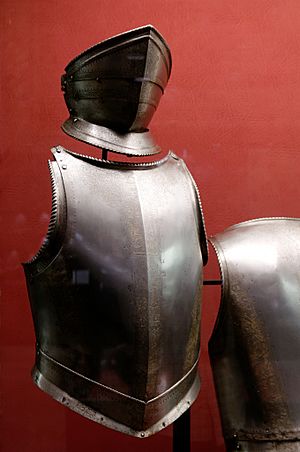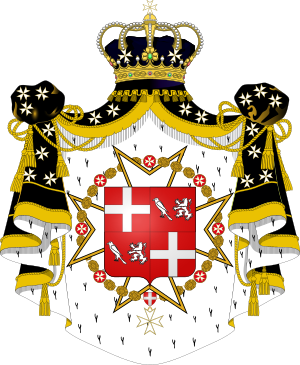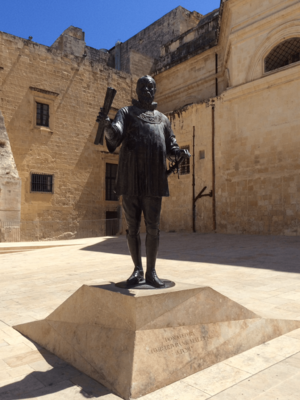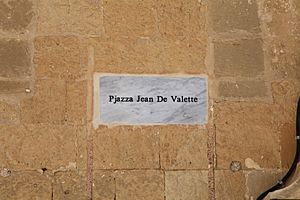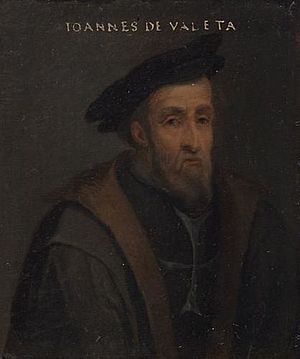Jean Parisot de Valette facts for kids
Quick facts for kids
Jean Parisot de Valette
|
|
|---|---|
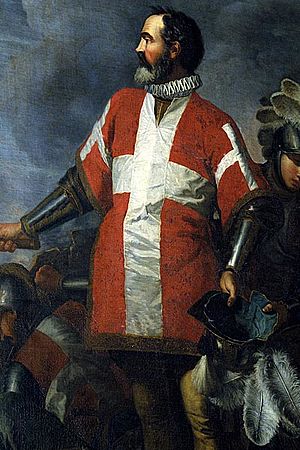 |
|
| Grand Master of the Order of Saint John | |
| In office 21 August 1557 – 21 August 1568 |
|
| Monarch | King Philip I |
| Preceded by | Claude de la Sengle |
| Succeeded by | Pierre de Monte |
| Governor of Tripoli | |
| In office 1546–1549 |
|
| Appointed by | Juan de Homedes y Coscon |
| Preceded by | Cristofano de Solís Farfan |
| Succeeded by | Pedro Nuñez de Herrera |
| Personal details | |
| Born | 4 February 1495 Parisot, Rouergue, France |
| Died | 21 August 1568 (aged 73) Hospitaller Malta |
| Resting place | St. John's Co-Cathedral (originally buried at the Church of Our Lady of Victories) |
| Domestic partners | Catherine Grecque and other mistresses |
| Children | Barthélemy de Valette Isabella Guasconi possibly other illegitimate children |
| Military service | |
| Allegiance | |
| Years of service | 1514–1568 |
| Rank | Captain General of the Galleys (1554–1557) Grand Master (1557–1568) |
| Battles/wars | Siege of Rhodes Great Siege of Malta |
Jean Parisot de Valette (born February 4, 1495, died August 21, 1568) was a brave French nobleman. He became the 49th Grand Master of the Order of Malta. He led the Order from August 21, 1557, until his death in 1568.
As a Knight Hospitaller, he fought bravely against the Turks in Rhodes. Later, as Grand Master, Valette became a hero for the Order. He led the defense against the Ottomans during the Great Siege of Malta in 1565. This siege is often seen as one of the most important sieges in history.
The city of Valletta was founded by Grand Master La Valette in 1566. Sadly, he passed away in 1568 and did not live to see the city finished. Pierre de Monte became the next Grand Master after him.
Contents
Early Life and Family History
Jean Parisot de Valette was born into the noble La Valette family in Quercy, France. This family had been important in France for many generations. Many family members had taken part in the Crusades.
His grandfather, Bernard de La Valette, was a Knight and served the King. His father, Guillot, was a Chevalier de France. Jean Parisot was also a distant cousin of Jean Louis de Nogaret de La Valette, the first Duke of Épernon.
While his birth year is usually given as 1494, some historians believe he was born in 1498. This is because two writers from the time of the Great Siege of Malta said he was 67 years old during the siege.
Joining the Knights and Early Career
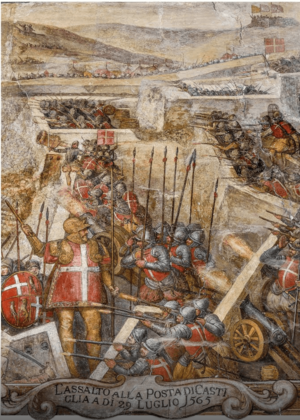
La Valette joined the Order of Saint John around 1514 when he was about 20 years old. He never returned to France or his family's home after that. He was present during the Great Siege of Rhodes in 1522. After the Ottoman Turks captured Rhodes, he left with Grand Master Philippe Villiers de L'Isle-Adam.
After losing Rhodes, the Order was given the islands of Malta and Tripoli by Emperor Charles V. In 1538, he was put in prison in Gozo for four months after an incident. In 1541, La Valette fought in a naval battle. He was wounded, and his ship, the San Giovanni, was captured.
Barbary pirates, led by Turgut Reis, held La Valette as a galley slave for a year. He was later freed in a prisoner exchange. In 1546, La Valette became the Governor of Tripoli. He worked to bring order back to the city, which was in a difficult situation.
In 1554, he was chosen to be the Captain General of the Order's galleys. This was a great honor for the Langue of Provence. This position was usually held by a Knight from the Italian Langue. In this role, he became famous as a great sea captain. He was as respected as the Chevalier Mathurin Romegas, another top Christian naval commander.
La Valette was known for being a very handsome man. He could speak several languages fluently. These included Italian, Spanish, Greek, Arabic, and Turkish.
Becoming Grand Master
In 1557, after Grand Master Claude de la Sengle died, the Knights chose La Valette as their new Grand Master. They knew a big attack was coming. In 1560, he joined forces with the Habsburg Empire to try and take back Tripoli. However, this mission ended in a defeat for the Christian forces at the Battle of Djerba.
Despite this loss, the Order's ships managed to save several other Christian vessels. Later in his time as Grand Master, La Valette made the Order's navy much stronger.
The Great Siege of Malta
In 1565, La Valette organized the defense of Malta. He fought bravely during the Great Siege of Malta and successfully pushed back the Turks. During the siege, the Christian defenders were greatly outnumbered. They held out for over three months against an Ottoman force of at least 30,000 soldiers. This force included the Janissaries and a fleet of about 193 ships.
The battle saw Fort St. Elmo fall after about a month of fierce fighting. However, the Order managed to hold out in Birgu and Senglea until a relief force arrived. Ottoman engineers had thought Fort St. Elmo would fall in just three days.
Towards the end of the siege, Knight Commander Le Sande arrived with more soldiers from Sicily. He ordered a large charge from the Maltese hills. They attacked the Ottoman forces until the Ottomans retreated to the sea. The sea turned red from all the blood lost. At that point, the Ottoman forces got on their ships and sailed back to Constantinople. They thought about attacking again but had lost too many men and supplies. Their morale was too low for another big attack.
After the siege, a Maltese soldier made up a song that became famous:
Malta of gold, Malta of silver, Malta of precious metal,
We shall never take you.
No, not even if you were as soft as a gourd,
Not even if you were only protected by an onion skin!
And from Malta's walls, a voice replied:
I am she who has decimated the galleys of the Turk -
And all the warriors of Constantinople and Galatia!
Because the Order won this battle, La Valette became very famous in Europe. He was offered the chance to become a cardinal, but he said no. He wanted to keep the Order independent from the Pope. This showed his modesty and humility as a warrior monk.
Building Valletta and His Death
After the great siege, La Valette ordered the building of a new city called Valletta in 1566. He personally laid the first stone. This happened on the slopes of Mount Sciberras. This was the same place where many Turkish soldiers had died trying to storm Fort Saint Elmo. The Turks had thought the fort would fall in a few days, but the brave defenders held it for 30 days.
The city was named after its founder, Humilissima Civitas Vallettae, meaning "Most Humble City of Valletta". It became known as the most grand and exclusive fortress city in Europe, often called "Superbissima" (the "Most Proud"). Valletta is still the capital of Malta today.
La Valette suffered a stroke while praying in a chapel. He died soon after, on August 21, 1568. This was exactly eleven years after he became Grand Master. He never saw the city of Valletta completed. His tomb is in the Crypt of the Conventual Church of the Order. This church is now called St. John's Co-Cathedral and is inside Valletta.
The words on his tomb were written by his Latin Secretary, Sir Oliver Starkey. Sir Oliver was the last Knight of the English Langue during the Great Siege. The inscription says in Latin:
Here lies La Valette.
Worthy of eternal honour,
He who was once the scourge of Africa and Asia,
And the shield of Europe,
Whence he expelled the barbarians by his Holy Arms,
Is the first to be buried in this beloved city,
Whose founder he was.
Legacy and Recognition
La Valette is best known for winning the Great Siege and founding the city of Valletta. A street in the town of Naxxar is named after him. Also, the main ship of Virtu Ferries, M/V Jean de La Valette, carries his name. La Valette has also appeared many times on Maltese stamps, coins, banknotes, and phone cards.
Jean de Valette Square
In 2012, a square in Valletta was opened and named Pjazza Jean de La Valette. It features a statue of the Grand Master. The statue is 2.5 meters (about 8 feet) tall and was made of bronze by local sculptor Joseph Chetcuti. In the statue, La Valette is shown wearing armor. He holds a plan of Valletta in one hand and a sword in the other.
For many years, people commonly used the surname de La Valette. However, during the statue's unveiling in November 2012, historian Giovanni Bonello said that the Grand Master always signed his name as de Valette, without the La. A week later, Désireé von la Valette Saint Georges, a descendant, said the family name was de la Valette. Since then, there has been some discussion about his exact name.
Members of the Valette family used both versions at the time. But the Grand Master himself never used the La. In fact, all 138 coins and 19 medals made by the Order during his rule show the names de Valette, de Valetta, or just Valette. Bonello also suggested that the La might have been added because the city of Valletta was often called La Valletta. People then started including the La in the Grand Master's name.
Today, the name de Valette is used in Malta. However, many people still say de La Valette because that's what they remember. The Sovereign Military Order of Malta, which is the Order's successor, calls the Grand Master Fra' Jean de La Vallette-Parisot.
In Books and Stories
Because of his important role in defending Malta during the 1565 siege, de Valette has appeared as a main or supporting character in several books:
- Angels in Iron (1997) by Nicholas Prata: De Valette is the main character.
- Ironfire: An Epic Novel of War and Love (2005) by David W. Ball: De Valette is a supporting character.
- The Religion: A Novel (2007) by Tim Willocks: De Valette is a supporting character.
- The Course of Fortune (2015) by Tony Rothman: De Valette is a supporting character, with the surname de Valette.
- Eight Pointed Cross (2011) by Marthese Fenech: Valette is a supporting character.
- Valette is also important in Marthese Fenech's second novel, Falcon's Shadow (2020).
- The Great Siege (1961) is a historical book about the 1565 siege.
- Πανάκεια (2008) / Panacea, a Greek adventure novel by Παναγιώτης Κονιδάρης: De Valette is a supporting character.
See also
 In Spanish: Jean Parisot de La Valette para niños
In Spanish: Jean Parisot de La Valette para niños


